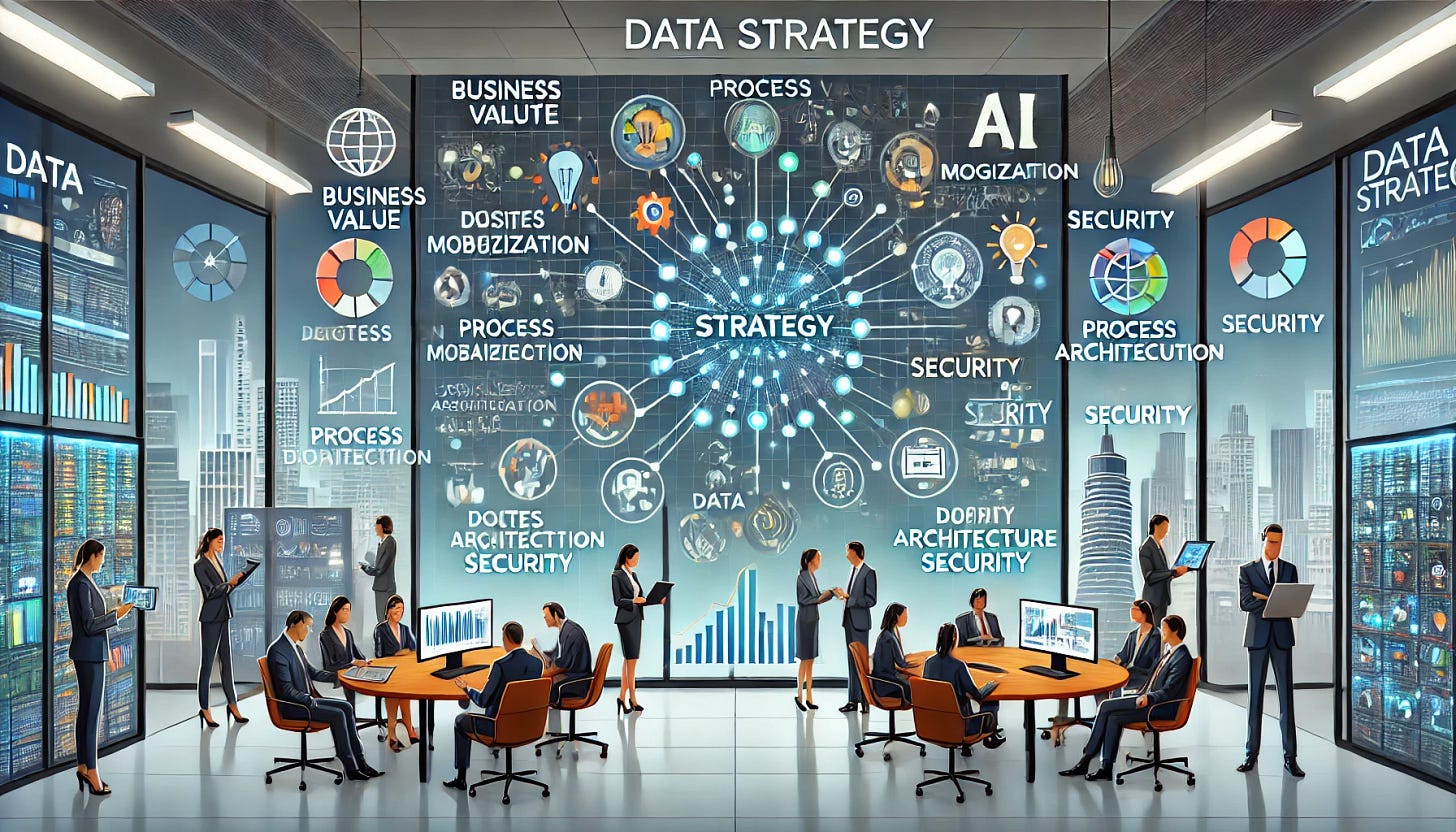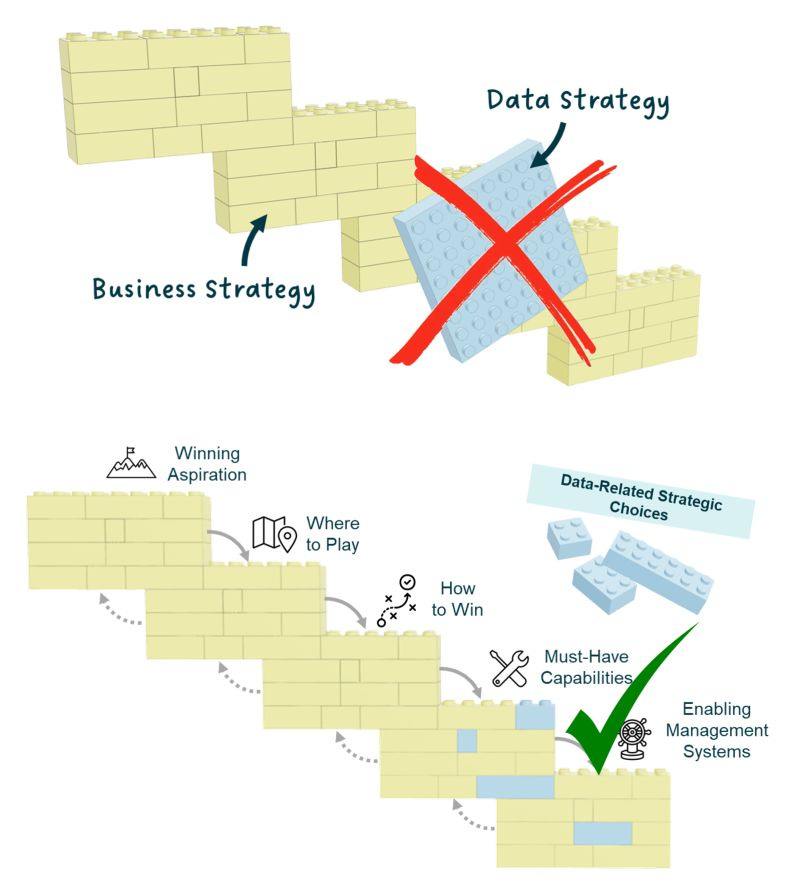Data Strategy is hard…
You need to understand the companies need
The meaning of what a data strategy should be is not very unified
If you have never done it before, it can be a strong change for your company
When I’m asked to work out a Data or AI Strategy I typically follow the following process:
Understanding the actual and desired picture for Data & AI
Development of target pictures from different perspectives and, if necessary, in several variants - depending on the goals and context for the data strategy
Roadmap and actions to implement the Data & AI Strategy
For me as a consultant with an inside-out perspective, it is additionally special because I first have to learn something about the company and so it depends much on what people are telling my. Typically not much is documented and if so, it is at least partly obsolete.
Asking the Right Questions
Finding ways to ask the right questions is therefore crucial. Shane Gibson discuss his typical questions some time ago on LinkedIn:
Fig. 1: Shane Gibson’s Data Blueprint process on LinkedIn
These questions are already very good and you will get a strong understanding and foundation for a Data & AI strategy with them.
Getting the Right Process and Tools
In general I don’t see many detailed descriptions, how exactly you can do a data strategy process. Therefore I appreciate the just published Data & Analytics Advisory Methodology by SAP, giving templates and explanations:
Fig. 2: Overview of SAP Data & Analytics Advisory Methodology
The approach has evolved over time. While in the core mainly focusing on data architecture, it is now enhanced by considering also data culture, data governance and further aspects.
Understanding what Data Operating Model Means
In a recent LinkedIn discussion about the Data & Analytics Capability Model used, Henrick Göthberg mentioned “The major issue with the example map is that it does not recognize Data and AI as a Socio-technical topic. It is not clear from the map what are the different teams that needs different practices and patterns.“. That’s right. A missing part here is the Data Operating Model e. g. described here by Dylan Anderson:
Fig. 3: “There is a lot to think about within an Operating Model, but these three levels helps distil how to think about it logically“ from “Issue #13 - Defining the Data Operating Model“
From my experience you can not completely define a data operating model within a first iteration of a data strategy. It is important to implement it by working the details out and adapt things as necessary what makes change management an important part of it. I just had a customer telling me “we changed the team through reorganization 3-4 times in the last two years. Data Strategy should focus on the architecture first.”. Sometimes some aspects are non-negotiable.
Understanding the Strategy Process
Recently I was really impressed so see the huge article “How Most Organizations Get Data & AI Strategy Wrong — and How to Fix It“ by Jens Linden delivering a playbook for data strategy:
Fig. 4: Data Strategy based on the Playing to Win Framework
His idea is, Data & AI Strategy is not about “does not define how organizations create a competitive advantage with Data, Analytics and AI“, because this is what a business strategy already should define, but rather “the strategy for the data, analytics, and AI function. It is a theory for how data teams win with their internal customers by delivering data products and analytical services.”.
In his detailed article he gives not only a good understanding incl. examples and tools of how to work out a data strategy. He also define the framework for strategy behind. Just to repeat his wrap-up here but I would recommend everyone really interested in data strategy to invest the time:
A data strategy is not a standalone supplement to business strategy, nor is it a plan for building data capabilities. It is rather the strategy of a data function, providing services to the internal data customers.
A data strategy does not define how an organization creates value with data, analytics and AI. This is the job of the business strategy with data-related strategic choices being an integral part.
Misconceptions about data strategy, combined with weak business strategy design, prevent organizations from leveraging data effectively. These issues hinder their ability to gain a competitive advantage.
The Playing to Win framework helps organizations with both: embedding data innovation into their business strategy and designing effective data strategies.
Conclusion
So far so good, but now, why is it important to craft a Data & AI Strategy? I thought, first it is important to understand what a data strategy is about. As you see, this is already a challenge. If you are a Data Engineer or a Data Scientist I often see these roles focusing into single use cases, but not seeing the big pictures. As Head of Data you have to balance your people, business and your CIO/CDO. Strategy often comes short. As business you want to focus on your goals and even handling data or discussing something not very specific to their domain can get a challenge.
Data strategy is the opportunity to realize the value of data for your company.It can be the north star to understand better about, why to decide left or right, even in daily business.
Lately in a project of data strategy execution I heard sometimes “What strategy thinks, doesn’t work”. This comes typically from a limited view on the big picture and reminds us how important communication and change management is. Not everyone will be convinced, not everyone want change, not everyone can wait until they see the results. But we have to imagine that without a Data & AI strategy, people would not even think about why they are doing things the way we do. The would not even say “it doesn’t work”.
Another recent situation are CxO’s pushing GenAI lighthouse projects because of the trends and what competitors does. Nothing wrong with that with the right understanding and prerequisites. But the same as someone focusing on single use cases, it will not generate value until it is well connected with the right data architecture, data team and data quality.
If only cost is your goal, what I also see much to often, you will focus on this and get the results. The result is a zero-sum game or worse. You have to have the big picture, even to decide what not to do.
Finally you can not have no data strategy. Take the chance to work with it, refine it, get feedback to make it work. In my experience a data strategy process is always an eye-opener. Without you will only build silos and islands of data in your company.
—> If you want to know more about how I approach Data & AI strategy, feel free to get in contact on LinkedIn.








I sense some contradictions here. Let me attempt to clarify.
You say “ Finally you can not have no data strategy.” I’m not sure what that statement means but I assume you are trying to say that all organisations must have a data strategy. Is that correct?
Given your references to Roger Martin above I’m assuming your view is therefore that strategy is not a plan. However since most of the article refers to things that I would consider plans I am confused. Roger Martin is very clear that “a plan is not a strategy”, which echoes the teachings of Henry Mintzberg and I agree, whether in the context of business strategy or data strategy.
You mention data strategy being the strategy for the data function and I wonder what happens if there is no data function? I see a lot of organisations that have no defined data function. Of course data engineering, analytics and modeling takes place but it is performed by people across the organisation, like marketing, sales, operations, finance. In this case is the whole organisation deemed to be the data function?
If the whole organisation is considered to be the data function (and there is no dedicated data team) then what is the difference between the data choices in the business strategy and the data strategy?
Finally, even in organisations that have dedicated data functions there is usually some data analytics work done outside of the dedicated data function. How is that work steered (i.e. how are choices made) within your view of the world?
Developing a data strategy, while usually viewed as essential by data types, can be seen as removing or reducing power from many isolated “domains” around the business, whatever the actual case may be. This may be true even with abundant engagement.
How can we improve the process of developing an enterprise data strategy?